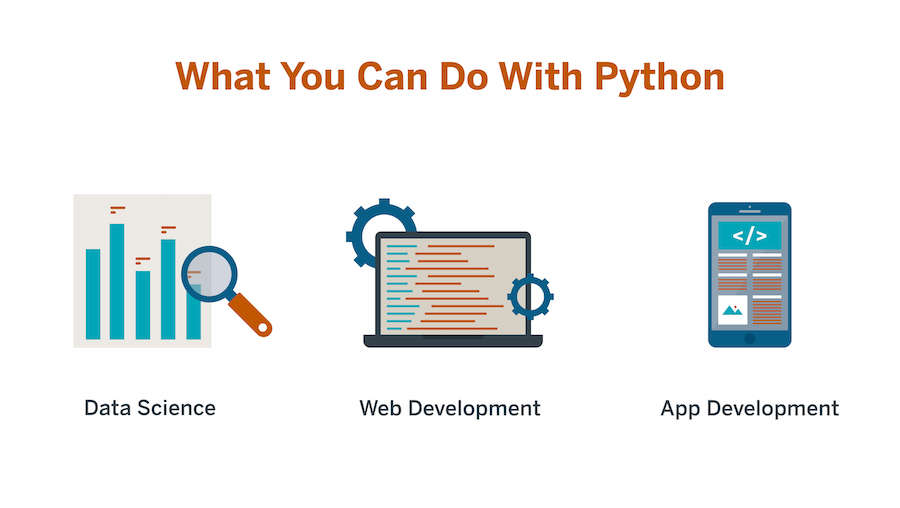Why Learn Python? Five Reasons to Start Programming With Python

Python is an in-demand, accessible programming language with an active, ever-growing community of users. For anyone looking to switch careers into the tech world through coding, Python is a great place to start. It’s relatively easy to learn and incredibly versatile, and it’s used in a variety of fields, from data science and machine learning to game design.
This article will review five top reasons to learn Python programming, as well as the educational paths that you can take to gain this valuable skill set.
What Is Python?
Python is a general-purpose programming language, which means that, unlike JavaScript, HTML, and CSS, it can be used in applications beyond web development. Though it’s been around for 30 years, it has recently become one of the most popular programming languages, and its popularity continues to grow.
1. Python Is Beginner-Friendly
Why learn Python? For starters, the language is an excellent place to begin if you’re new to coding. One of the biggest hurdles for aspiring coders is the daunting task of learning a new language that looks nothing like what they’re used to reading and writing. However, Python features English syntax and was designed to be concise and easy to read — all of which makes it more accessible to first-time coders than many other languages.
Python is also easy to learn because it is an interpreted programming language. This means that you can run each line of code once you have finished writing it, allowing you to immediately check it and make adjustments if needed — a big help to those who are still learning and a time-saver for coders everywhere.
2. Python Is Versatile
Python is highly versatile. You can use it for both small and complex tasks, and it is used across many different industries — from its more common applications in data science and software engineering to environments like mobile app development, artificial intelligence, and machine learning. This multifaceted use is due to the wide array of Python libraries available (over 125,000, to be specific). Libraries are collections of pre-written code in a particular language that anyone can access, meaning that once you’ve learned the basics of Python, you’ll likely be able to understand and use a huge amount of code developed by other programmers.
Another important aspect of Python’s versatility is its ability to run with other programming languages. A few common examples of Python implementation with other languages are Jython (Python integrated with Java) and CPython (Python integrated with C). Lastly, Python offers cross-platform functionality, meaning that it will function properly whether you’re working with Windows, Linux, or macOS.
3. Python Developer Roles Are in High Demand
Python developer roles are in high demand, as many major companies — including DropBox, Netflix, and Facebook — use it. Google has even made its own Python style guide. Python developer jobs are also comparatively lucrative. According to Indeed*, Python developers earn an average salary of $108,391, which makes it the fourth-most lucrative programming language behind Ruby ($120,174), C++ ($114,000), and JavaScript ($111,623). Python developers also have the opportunity to earn a high salary with less experience, according to StackOverflow.
4. Python Boasts a Supportive Community
When you’re learning a new programming language — particularly after you’ve completed your bootcamp course or degree — you’ll want to feel confident that you have a community of programmers you can turn to with questions when an issue comes up. One major benefit of Python is its robust and supportive online community, as evidenced by the 1.5 Million GitHub repositories that make Python the platform’s second-largest community. Python also has its own network of robust community forums, where users can discuss everything from workflow to software development, and Python users often organize meetups around the world to build community and knowledge bases.
5. Python Is the Fastest-Growing Programming Language
When it comes to Python’s popularity and growth rate, the numbers don’t lie. According to the PYPL PopularitY of Programming Language Index, Python is the most-searched programming language on the internet — and that doesn’t look like it will be changing any time soon. According to Stack Overflow, Python is also the fastest-growing programming language, and TIOBE gave it the 2020 Programming Language of the Year award as it gained popularity faster than any other language. Part of this acclaim is due to Python’s usefulness in the world of data science; as fields like machine learning, data modeling, and AI grow, so too does the demand for Python-related skills. All of this means that, if you’re looking for a new programming language to learn — or looking to transition into the field of programming — Python is a wise choice.
What You Can Do With Python: Top 3 Uses
Data Science
According to a survey from Kaggle, an online community for data scientists, Python is the field’s most-used programming language. In addition to Python’s time-saving libraries, the language’s ability to analyze large data sets very quickly and carry out repetitive tasks make its popularity more than warranted.
Web Development
Since Python is such a flexible programming language, it can make it easier to build complex web utilities. Python’s various web frameworks are especially useful — like the popular Django, which can make building both back end and client-side functionality easier and faster. Even large companies use Python for web development; both Google and YouTube have used it extensively for many of their digital infrastructures.
App Development
Python is an excellent choice for anyone looking to get into app development. It’s an ideal language for prototyping because of its lower development time and effort. As with web development, app development is made easy by Python’s cross-platform abilities. Specifically, Python has recently become popular in the fast-growing sectors of blockchain app development and gaming app development thanks to its robust frameworks and real-time testing.

3 Learning Options for Getting Started With Python
As with any programming language, there are a variety of different ways to learn Python. These options include bootcamps, traditional degrees, and self-guided learning. Each pathway has unique benefits — just as every aspiring coder has their own set of needs, interests, and constraints. Your career goals will be an important factor in deciding how to learn Python. Some avenues will focus specifically on Python while others will provide more opportunities to learn other programming languages and skills in tandem with Python.
1. Data Analytics Bootcamps
Bootcamps are intensive programs that teach a variety of programming languages and skills and typically take three to six months to complete. They also tend to offer flexible schedules for students who need to maintain a job or other responsibilities but also want to gain the skills to become programmers. Data analytics bootcamps focus on teaching the skills needed to solve and analyze complex data problems. Students learn the fundamentals of data analytics, from Excel functions like pivot tables and VBA scripting to front end web visualization tools like HTML and JavaScript charting.
At The Data Analysis and Visualization Boot Camp at Texas McCombs, students learn the basics of working in Python, as well as how to use data-focused Python libraries like NumPy and Pandas. The bootcamp curriculum teaches students how to transform vast amounts of data into meaningful insights that they can act on to gain strategic advantage for themselves or their organization. Plus, they’ve got the professional portfolios to prove it.
Get Program Info
Why Should You Consider Learning Python in a Data Analytics Boot Camp?
For those who want to pursue jobs in the fields of data analytics and data science, a data analytics boot camp with a focus on Python is an excellent, timely choice. Since Python is widely used in the world of data science and only growing in its popularity, it is an important tool for anyone getting started in data science.
Learning Python as part of a wider data analytics skill set will make you a stronger candidate, as data analysts are expected to have a wide array of skills. They must know how to collect, sort, and analyze complex data sets, as well as understand and predict trends, communicate their insights, and work with other teams within their companies. But data analyst jobs aren’t the only available positions for graduates from these programs: they are also eligible for jobs as data scientists, business analysts, and software developers, to name a few.
2. Traditional Degrees
For those seeking job opportunities in advanced data science or computer science, a traditional university degree can be a promising educational option.
Many people looking to get into software development, for example, may have to make the decision between a coding bootcamp and a computer science degree. While traditional degrees require a far larger investment of time and money, they allow students to study their concentration topics more deeply, as well as take courses that are of interest to them but not relevant to their major. Computer science is the most popular degree for those interested in coding, and will include courses on Python and other programming languages.
To learn more about traditional university degrees, you can visit the UT Austin website for information on courses of study.
Those looking to expand on their degrees can pursue continuation courses, like the Coding Boot Camp at UT Austin. This specific bootcamp allows you to increase your employability by offering supplemental study options in programming languages like Python, as well as AWS, at no additional cost for enrolled students.
3. Independent Learning
For those with an interest in self-teaching, independent learning options such as free courses and educational apps on coding (and Python, in particular) are a great route. For example, edX has a robust selection of courses on Python that potential coders can use to teach themselves the language. Python makes independent learning options particularly worthwhile because of the robust online community it boasts — anyone looking to teach themselves the language can benefit from the programmers who are willing to offer their knowledge and resources online.
Python is a general-purpose programming language that is quickly gaining in popularity. Unlike JavaScript, HTML, and CSS, it can be used in applications outside of web development, which makes it a very flexible programming language. Python’s basis is in English syntax, making it easy to read and accessible to first-time coders.
Python is used in a wide variety of careers, from data science to web and app development to game development. It’s great for sifting through large sets of data, which is why data scientists and analysts love it. But, it is also popular among software developers, particularly given its easy integration with other programming languages. Even professionals in financial advising and product management can make use of Python.
There are a variety of ways to learn the Python programming language. Many people choose to learn Python through bootcamps, which are intensive courses that often focus on a defined set of coding languages or skill sets and allow you to learn on a flexible schedule. You may also choose to pursue a computer science degree at a traditional university, which would allow you to learn Python along with broader interests. There are also many self-taught options available on the internet.
Python is appealing to people working in artificial intelligence and machine learning given its simple, reliable code and extensive libraries and frameworks. Frameworks like scikit-learn offer many of the functionalities necessary for the field of machine learning. In these industries, Python is used for data science and visualization, computer vision, and natural language processing, among other things.
It generally takes an average of 3 months to learn a new programming language, and Python is no different. Most bootcamps last around three to six months. Traditional university degrees are also good venues for learning Python through a broader, cross-industry focus. If you choose a self-taught course, the amount of time it takes to learn Python will likely depend on your schedule and level of commitment.

 Live Chat
Live Chat